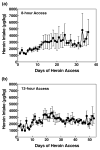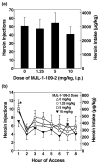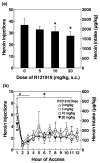Corticotropin-releasing factor-1 receptor antagonists decrease heroin self-administration in long- but not short-access rats
- PMID: 19291009
- PMCID: PMC2748834
- DOI: 10.1111/j.1369-1600.2008.00142.x
Corticotropin-releasing factor-1 receptor antagonists decrease heroin self-administration in long- but not short-access rats
Abstract
Dysregulation of the stress-related corticotropin-releasing factor (CRF) system has been implicated in the development of drug dependence. The present study examined the effects of administering CRF type 1 (CRF(1)) receptor antagonists on heroin self-administration in animals allowed short (1 hour) or long (8-12 hours) access to intravenous heroin self-administration sessions. The nonpeptide CRF(1) antagonists MJL-1-109-2 (1 hour versus 8 hours access) or R121919 (1 hour versus 12 hours access) were systemically injected in both short- and long-access rats. MJL-1-109-2 (10 mg/kg) and R121919 (10 and 20 mg/kg) reduced heroin self-administration in long-access animals without altering heroin intake in short-access animals. Both MJL-1-109-2 and R121919 decreased first-hour intravenous heroin self-administration selectively in long-access rats, with R121919 decreasing cumulative heroin intake across the 12-hour session. The results demonstrate that blockade of the CRF-CRF(1) receptor system attenuates the increased heroin intake of rats with extended access to the drug.
Figures






Similar articles
-
Development of mechanical hypersensitivity in rats during heroin and ethanol dependence: alleviation by CRF₁ receptor antagonism.Neuropharmacology. 2012 Feb;62(2):1142-51. doi: 10.1016/j.neuropharm.2011.11.006. Epub 2011 Nov 23. Neuropharmacology. 2012. PMID: 22119954 Free PMC article.
-
CRF(1) receptor antagonists attenuate escalated cocaine self-administration in rats.Psychopharmacology (Berl). 2008 Feb;196(3):473-82. doi: 10.1007/s00213-007-0983-9. Epub 2007 Oct 30. Psychopharmacology (Berl). 2008. PMID: 17965976 Free PMC article.
-
Corticotropin-releasing factor 1 antagonists selectively reduce ethanol self-administration in ethanol-dependent rats.Biol Psychiatry. 2007 Jan 1;61(1):78-86. doi: 10.1016/j.biopsych.2006.03.063. Epub 2006 Jul 28. Biol Psychiatry. 2007. PMID: 16876134 Free PMC article.
-
Don't stress about CRF: assessing the translational failures of CRF1antagonists.Psychopharmacology (Berl). 2017 May;234(9-10):1467-1481. doi: 10.1007/s00213-017-4556-2. Epub 2017 Mar 7. Psychopharmacology (Berl). 2017. PMID: 28265716 Free PMC article. Review.
-
Recent advances with the CRF1 receptor: design of small molecule inhibitors, receptor subtypes and clinical indications.Curr Pharm Des. 1999 May;5(5):289-315. Curr Pharm Des. 1999. PMID: 10213797 Review.
Cited by
-
The duration of intermittent access to preferred sucrose-rich food affects binge-like intake, fat accumulation, and fasting glucose in male rats.Appetite. 2018 Nov 1;130:59-69. doi: 10.1016/j.appet.2018.07.025. Epub 2018 Jul 29. Appetite. 2018. PMID: 30063959 Free PMC article.
-
Craving, context and the cortex.Nat Neurosci. 2011 Apr;14(4):409-10. doi: 10.1038/nn.2787. Nat Neurosci. 2011. PMID: 21445066 Free PMC article.
-
Motivational Processes Underlying Substance Abuse Disorder.Curr Top Behav Neurosci. 2016;27:473-506. doi: 10.1007/7854_2015_391. Curr Top Behav Neurosci. 2016. PMID: 26475159 Free PMC article. Review.
-
Neurobiological mechanisms of addiction: focus on corticotropin-releasing factor.Curr Opin Investig Drugs. 2010 Jan;11(1):63-71. Curr Opin Investig Drugs. 2010. PMID: 20047160 Free PMC article. Review.
-
Converging vulnerability factors for compulsive food and drug use.Neuropharmacology. 2021 Sep 15;196:108556. doi: 10.1016/j.neuropharm.2021.108556. Epub 2021 Apr 20. Neuropharmacology. 2021. PMID: 33862029 Free PMC article. Review.
References
-
- Ahmed SH, Koob GF. Transition from moderate to excessive drug intake: change in hedonic set point. Science. 1998;282:298–300. - PubMed
-
- Ahmed SH, Koob GF. Transition to drug addiction: a negative reinforcement model based on an allostatic decrease in reward function. Psychopharmacology (Berl) 2005;180:473–490. - PubMed
-
- Ahmed SH, Walker JR, Koob GF. Persistent increase in the motivation to take heroin in rats with a history of drug escalation. Neuropsychopharmacology. 2000;22:413–421. - PubMed
-
- Ahmed SH, Kenny PJ, Koob GF, Markou A. Neurobiological evidence for hedonic allostasis associated with escalating cocaine use. Nat Neurosci. 2002;5:625–626. - PubMed
-
- Azar MR, Jones BC, Schulteis G. Conditioned place aversion is a highly sensitive index of acute opioid dependence and withdrawal. Psychopharmacology (Berl) 2003;170:42–50. - PubMed
Publication types
MeSH terms
Substances
Grants and funding
LinkOut - more resources
Full Text Sources
Medical

